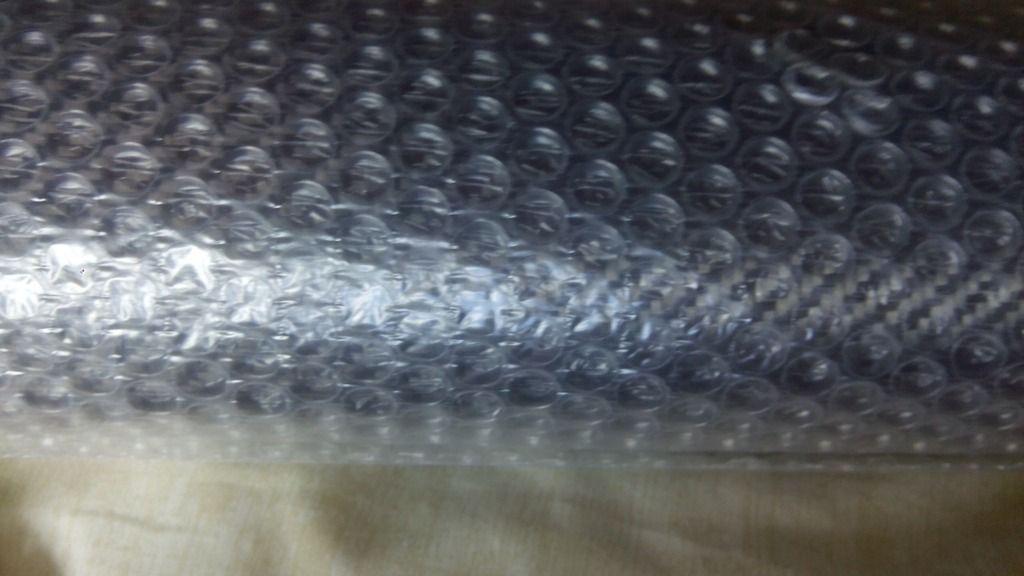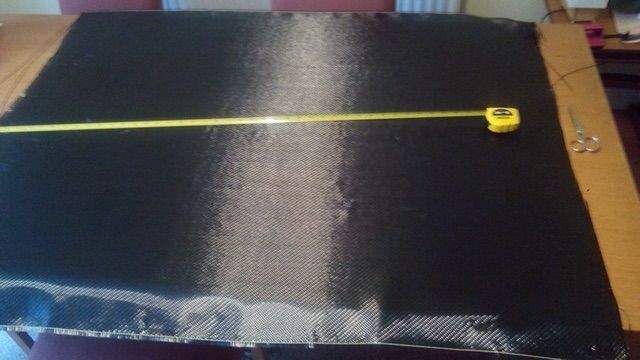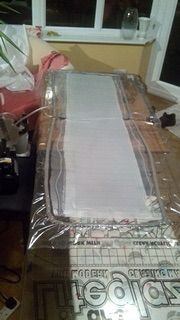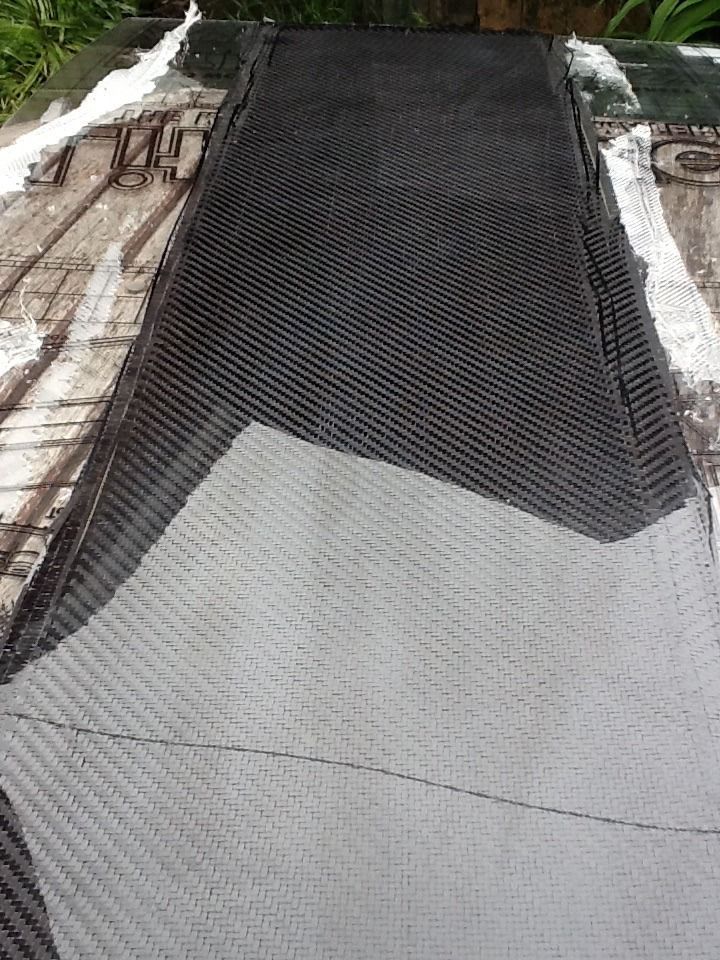OliilO
|
| posted on 14/6/15 at 05:33 PM |

|
|
Making Carbon Fibre Stuff (Resin Infusion)
I've posted this on SKCC as well, but hopefully it might help anyone else who wants to give making cf stuff a go.
Quite a while ago (last year), I came across some of the easycomposites videos about making carbon fibre stuff. The videos made it look really easy
(ha!) and I wanted to replace a few panels on my car as they are looking a bit tatty through age and an off road excursion. Clearly it made sense to
replace them (and build some other bits) with carbon fibre; but the kit involved quite a lot of £££, so I postponed.
Then 2 weeks ago, I thought 'sod it' and invested in a resin infusion kit and some materials...
The ultimate aim will be to make the following (roughly in priority order); boot panel, cycle wings, flared side panels, dash, aeroscreen,
transmission tunnel cover, arches, anything else that looks like it could be cf...
Firstly, I decided to try and make a simple flat panel (to use as a boot panel) to let me understand the techniques before progressing to more
complicated stuff, so did that this weekend. I emailed a few people (including a chap on pistonheads who has made a whole cf body for his Noble) and
got some advice to try and avoid some basic mistakes.
So, after spending over half a bag of sand (    ) on stuff to make shiny things, I felt a bit affronted to be charged £10 for P&P. When
it all turned up though, I felt it wasn't so bad... ) on stuff to make shiny things, I felt a bit affronted to be charged £10 for P&P. When
it all turned up though, I felt it wasn't so bad...

Apologies for poor quality pictures from a phone.
Including a nice roll of carbon fibre cloth:

On Friday night I turned the conservatory into a makeshift workshop and decided to crack on with giving it ago. After all, how hard could it be?
I used an acrylic sheet as a base, after checking with that the acrylic and resin wouldn't react. I then applied 4 coats of easylease release
agent as per the instructions, before cutting the cloth to size. For this, I just wanted to make a boot cover so measured it out and then gave myself
a decent size margin to make sure I could trim the edges of the finished part and get a good finish.

[Edited on 14/6/15 by OliilO]
[Edited on 14/6/15 by OliilO]
|
|
|
|
|
OliilO
|
| posted on 14/6/15 at 05:35 PM |

|
|
I used 4 layers of 200gsm cloth, which in hindsight might have been too few layers. I laid the layers on the prepared area of acrylic and made sure
the first layer was laid out as well as possible as this would become the visible surface of the finished part.

Then built up the layers; a layer of peel ply on top of the cf, followed by the infusion mesh. Both cut to be slightly larger than the cf material. I
used infusion spiral at both sides of the part, but maybe should have used it only on the resin 'entry side'.
I then added the bagging material, trying to ensure a good seal all around the part. Then came the first big moment; connecting it to the pump and
drawing a vacuum. All seemed good and after a bit of fiddling it seemed to be holding a good vacuum so I clamped off the pump, turned it off and
waited to check there were no leaks. After 10 minutes the gauge hadn't dropped, so I thought I was ok to proceed.

So, mixed up the resin, unclaimed the line and started to draw resin through the part. Then realised I was going to run our of resin. Crap!!! So mixed
some more up quickly and saved that mistake.
After infusing it and clamping off both feed and pump lines, I noticed a load of bubbles appearing in the infusion mesh so had a panic. I then
realised I had a vacuum leak and had visions of spoiling £50s worth of materials...
Fortunately I found the leak and reseated it before doing what your never supposed to do. With the part clamped off, I broke the seal on the catch pot
and retrieved all the excess resin that had accumulated there before redrawing a vacuum and re infusing the part. Some bubbles still remained but it
looked better than before, so I sort of belieevd that I'd spoiled the part, left it to cure and went to bed accepting I couldn't do any
more.
I left it about 30 hours to cure, resisting the temptation to look at it early, and stripped off all the consumables this morning to leave me with the
following:

Success! I was elated that it came out as well as it did... The line in the foreground is a shadow from the washing line and the strands on the right
are on the edge that will be trimmed off to get the part to size. The finish isn't perfect, there are a few places where the strands have
separated slightly but it's pretty good. I'm more than happy with it as a first attempt.
So what did I learn?
1. Patience is a virtue... Take the time to ensure everything is correct and don't rush anything.
2. If making a flat sheet, screw the plastic down to something to stop it warping under vacuum (I had to weight the corners down).
3. Make liberal use of tape to stick the different layers in place.
4. I'd have been better infusing along the long axis. I thought it would be best to go across the part, but this just meant the middle was fully
infused and drawing resin to the catch pot while the corners hadn't drawn any resin
5. Make 100% sure you've not got any leaks and do a 30 minute leak test
6. Make more resin than you think you'll need.
7. Dont panic; a few bubbles in the infusion mesh isn't the end of the world.
8. Again, ensure you've got a 100% seal before infusing!
And finally, don't spill resin in the conservatory...
[Edited on 14/6/15 by OliilO]
|
|
|
bart
|
| posted on 14/6/15 at 05:57 PM |

|
|
HI OLI
good to see you making a start , its all about learning
I was told by easy composite not to mix up to much resin as like you did you can always mix up some more
as its going to take so long to gel.
they also told me a neat way to bake the stuff to get full properties I will email you as its a bit dangerous and not for public consumption 
try , try , and try again - to f--- up is human
BE ALERT > BRITAIN NEEDS LERTS
|
|
|
FuryRebuild
|
| posted on 15/6/15 at 02:28 PM |

|
|
Hi Olli
I've gone on exactly the journey you have - take a look at furyrebuild.co.uk where I document all my stuff -
mistakes and all.
Welcome to the carbon mutual support group.
Thanks
M
When all you have is a hammer, everything around you is a nail.
www.furyrebuild.co.uk
|
|
|
OliilO
|
| posted on 12/7/15 at 08:05 PM |

|
|
quote:
Originally posted by FuryRebuild
Hi Olli
I've gone on exactly the journey you have - take a look at furyrebuild.co.uk where I document all my stuff -
mistakes and all.
Welcome to the carbon mutual support group.
Thanks
M
I've now got a bit more time away from work, so am hoping to make some progress and get some new bits on the go over the next couple of weeks.
For the time being I'm going to avoid anything that involves rendering the car out of action, so I can make the most of the summer and use it a
bit!
When you replaced some of the aluminium skins on your Fury, what thickness CF did you make, and using what lay up? My first panel was 4 x 200gsm
layers, but was a bit flexible. I'm tempted to double it to get some more rigidity over longer spans; I know I could adapt the shape and build
in some webs to make a stronger panel, but don't want to go that way at the moment.
I'm tempted to put in a layer of Kevlar in the panels for the transmission tunnel/behind the seats in order to add a bit more impact resistance
to the panels.
|
|
|
FuryRebuild
|
| posted on 12/7/15 at 08:44 PM |

|
|
If you want rigidity you need a core. I abandoned the structural panel approach because the screw/rivet holes are too near the edge to be significant.
If you bonded it you would get a good result. In the end, I decided to make a full composite tub. It's going to have the equivalent of 14 layers
of 200 in there. I have a lot of 600gsm cloth.
Definitely put some aramid in there as well. A layer of two of e-glass will the a little splinter absorption should the worst happen.
When all you have is a hammer, everything around you is a nail.
www.furyrebuild.co.uk
|
|
|
OliilO
|
| posted on 12/7/15 at 08:55 PM |

|
|
14 layers would be fun to lay up, I need to get some heavier cloth to reduce layers when I next order some more.
I forgot to say in the last post that I intended to get some of the lantor core material and have a bit of a play. I want to make a flared side panel
too, so non structural, but am not sure if it's worth putting a core in it or just doing 4/5 400gsm layers to ensure its not too flexible.
Have you been lacquer img your finished items, or leaving them bare?
[Edited on 12/7/15 by OliilO]
|
|
|













